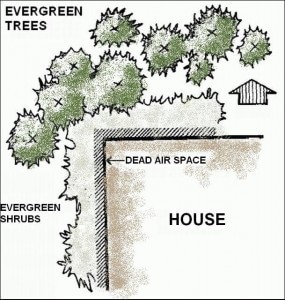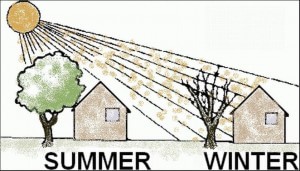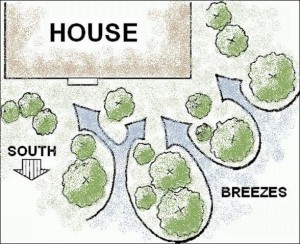On a cold winter day, nothing feels better than coming home to a toasty warm house. Who doesn’t enjoy that peaceful feeling as you sit down to watch the snow fall outside your window from the comfort of a reclining chair in a pleasant 70 degree environment? Life is good…then the utility bills arrive! With the recent cold snap, you have no doubt noticed a spike in your gas and/or electric bills. You probably also notice the same thing when that dread piece of mail arrives in July and August! You may be willing to move the thermostat a degree or two one way or the other, but comfort is still important and maybe the kids just don’t want to wear their winter coats at the kitchen table for dinner. You grit your teeth, reset the thermostat, and prepare to purchase ink by the barrel for writing checks to the utility company. If this sounds familiar, you may be surprised to know that some simple changes to your landscape can make a big difference in your energy bills.
There are 3 primary ways that your home may gain or lose heat: 1) air infiltration, 2) heat conduction, and 3) solar radiation. A carefully designed landscape that takes these things into account can help reduce home heating and cooling costs by 25%. This could mean hundreds of dollars in energy savings each year! In fact, the U.S. Department of Energy recently released a study showing that with even as few as 3 well positioned trees, you could see savings of $100 to $250 annually. Following some additional simple guidelines, you can make changes to your landscape that will leave you with even more green in your pocket.
In the winter, your home may be losing 20% to 30% of its heat due to air infiltration. One way to reduce that heat loss is by setting up windbreaks in your landscaping. By positioning evergreen trees and shrubs along the north and northwest sides of your property (the direction of Ohio’s prevailing winter winds), you may be able to reduce heating costs anywhere from 25% to 40%. Ideally your windbreak should be located 2 to 5 times as
far away from your house as the mature height of your trees. For example, if you are planting a double row of spruce trees that will reach a mature height of 30’, you should try to locate them 60’ to 150’ away from your house. While this is the optimal range, the size of your property may require you to plant a little bit closer than that. On the other hand, if you have a very large property, studies have shown that windbreaks are able to achieve noticeable results even when they are located as far away as 30 times the mature height of the plantings!
Unfortunately, the end of winter does not mean the end of utility bills! During summer, when you are trying to cool your home, you may be fighting the effects of solar radiation and heat conduction though your windows and walls. The best way to help keep your house cool is by shading it. In the same way that you seek out shade to cool off on a hot summer day, your home can be kept cooler by shading the roof and sun facing walls (primarily south and west) with trees and shrubs. The shade from your trees and shrubs can actually cool the surrounding air by as much as 9 degrees. This can dramatically reduce your air conditioning costs; possibly by as much as 50%. Just think of how many ice-cold lemonades that would buy! By planting deciduous shade trees on the south and west sides of your house, you can cool your home in the summer and still allow sunlight to shine through in the winter when you actually want to take advantage of the
solar radiation heating your home. Well positioned shrubs can also “insulate” your walls without inhibiting air flow. And don’t forget to shade your air conditioning unit. In addition to the aesthetic benefits of screening the air conditioner, a shaded unit can operate 10% more efficiently than one exposed to the hot summer sun.
When it comes to reducing your energy bills, landscaping can do more than just slow the wind and provide shade. Areas of lawn or groundcover can be up to 25 degrees cooler than asphalt in the summer so maximize the amount of planted area on your property and minimize pavement. While structures such as pergolas and trellises are helpful in providing shade to your home, you will not get the added cooling benefits of plant transpiration and
evaporation. Tree filled neighborhoods have been shown to have air temperatures that are 3 to 6 degrees cooler than surrounding open neighborhoods due to the combination of shade and the cooling effects of evaporation. If your home is not air conditioned, you can actually use plant material to direct summer winds toward your windows. (If you do have central air conditioning however you are actually better off not directing summer winds toward your home. Studies have shown that directing these warm winds toward your house is actually a detriment to keeping energy bills low when you are using air conditioning.)
There are numerous possibilities for how to use your landscape to reduce energy costs. The savings you could achieve may even pay for the landscape renovations within just 8 years! Contact Buck & Sons today to consult with a landscape designer and find out how you can use your landscaping to make your home more energy efficient. Don’t spend another winter lamenting huge utility bills! This year go green and save some green in the process! by Pete Marsh, Lead Designer – Buck & Sons Landscape




